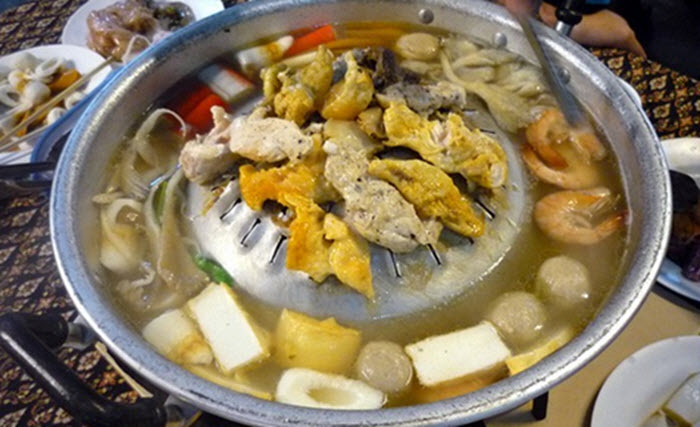5 June, 2016
Chim chum (dinner)

Chim chum, also known as Jim jum and Chaeo hon, is a popular street food in Thailand. The name chim chum is used both for the dish and for the earthenware pot in which the dish is cooked. This earthenware pot is heated over a brazier filled with hot coals.
The pot and the brazier is not hidden away in the kitchen; it will be placed on the table around which you and and fellow diners are seated. The pot is filled with broth, and to the broth various vegetables and herbs are added. You then use your chopsticks to put a peace of meat in the broth and let it cook quickly before you take it up again, dip it into nam chim (a sauce) and eat it. In Thai, chim means to dip something and chum means to drop something into liquid for a brief period of time.
Chicken and pork are among the most commonly used meats for chim chum, but the cooking method will work fine for a wide range of other proteins as well.
Examples of herbs that are often added to the broth to provide flavors – and sometimes also because of their alleged medical properties – are galangal, kaffir lime leaves, lemongrass and sweet basil.
Making and eating chim chum
- Start by cutting your protein of choice into bite-sized chunks. You can for instance use chicken, pork and tofu. The chunks should be so small that they will be cooked in less than a minute when dipped into boiling water.
- Marinate the chunks in a mixture of oyster sauce, light soy sauce and sugar. Ideally, let the protein marinate for at least twelve hours in the fridge.
- Prepare the dipping suace (nam chim) according to the instructions below. It should be allowed to rest for at least an hour before being eaten, preferably longer.
- The next step is to make chicken stock and bring it to a boil in the earthenware pot. If you don’t have access to homemade chicken stock, you can use bullion cubes and prepare them with water according to the instructions from the manufacturer.
- When the chicken broth is boiling, add your choice of vegetables and herbs. Start with the ones that need the longest time to cook (usually vegetables), and then add more tender greens later (typically leafy herbs). Thai Sweet Basil is one example of a herb that is added late.
- Remove the marinating meat (or other protein) from the fridge and put it on plates. Each dinner guest should have his or her own plate with raw meat chunks on it. Each dinner guest should also have their own small bowl with dipping sauce.
- Each person cooks their meat by dipping it into the broth using chopsticks. It is important that the broth is boiling when the meat is dipped into it. If the broth stops boiling because it’s been cooled down too much by meat, bring it to a boil again before any new chunk of meat is put in.
- When you have cooked a chunk of meat, dip it into your dipping sauce and eat it.
Side dishes can be added to the meal to make it more varied and balanced. You can for instance serve glass noodles, eggs and fresh vegetables. The glass noodles can preferably be flavored with some of the nam chim.
How to make nam chim
As mentioned above, the meat is traditionally dipped in a sauce called nam chim before its eaten. There are many different nam chims, and most of them are a combination of salty, sweet, spicy and sour ingredients.
Here is one example of an ingredients list for a popular nam chim:
- Garlic cloves, peeled and finely chopped
- Coriander roots, finely chopped
- Salt
- Red chili, finely chopped
- Green chili, finely chopped
- Thai green chili, finely chopped
- Palm sugar syrup
- Fish sauce
- Lime juice
- Shallots, finely chopped
The exact proportions of the ingredients should be adjusted to fit your own preferences. Don’t be afraid to experiment. The consistency of the finished product should be a liquid sauce, not a paste or puree, so you need to use quite a lot of liquid ingredients.
To make the nam chim, start by placing garlic, coriander and salt in a mortar and pounding them with the pestle. Don’t use a mixer. You are not supposed to reduce the ingredients to a paste, just pound them. Add the chilies and crush lightly. Add syrup, fish sauce, lime juice and shallots. Stir around the ingredients, but don’t overdo it. Leave the sauce to rest for at least one hour, preferably longer. The flavors will be more intense and complex if you allow the sauce to rest longer.
